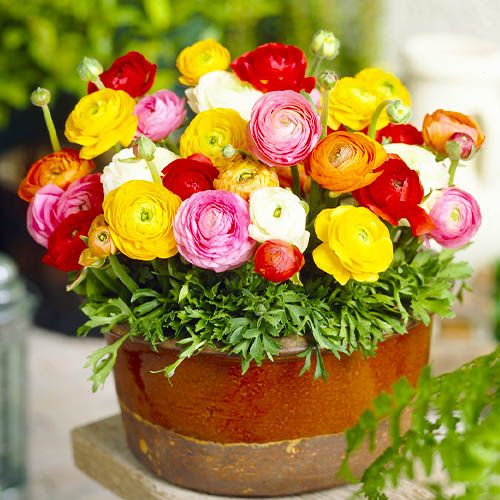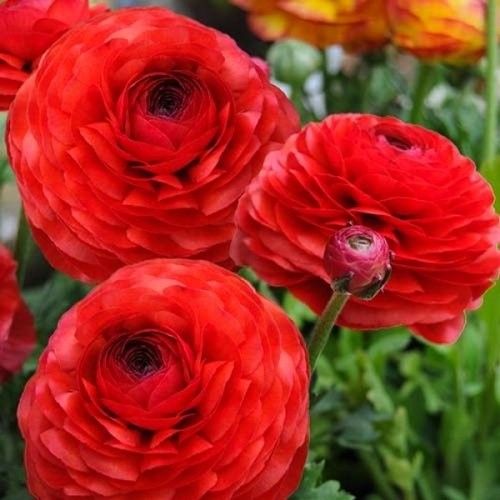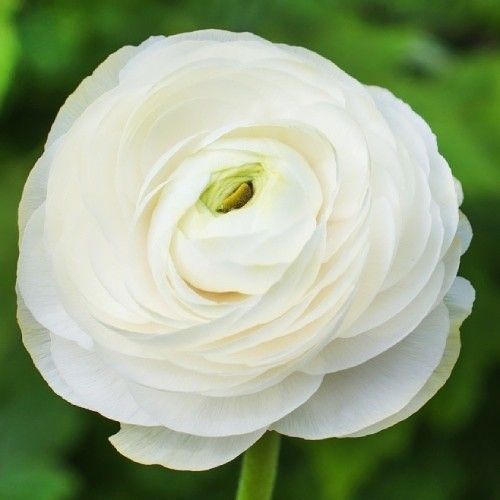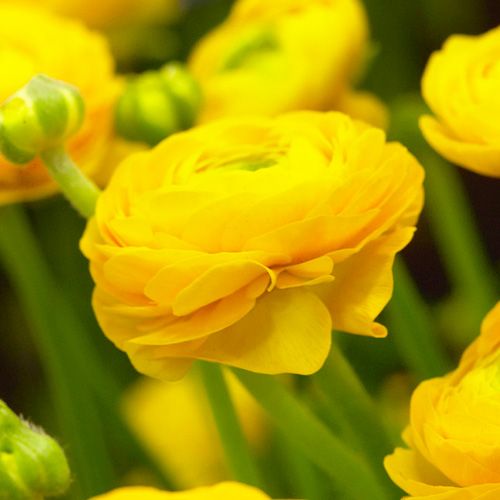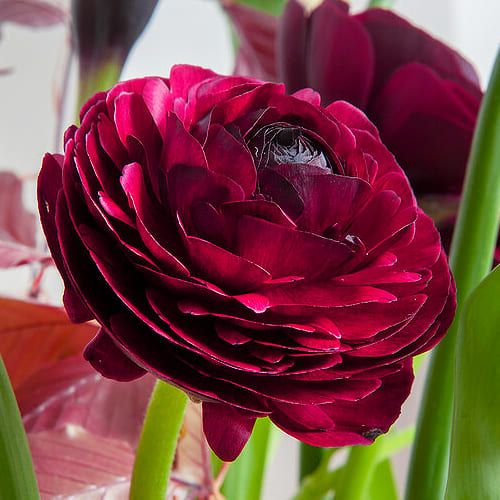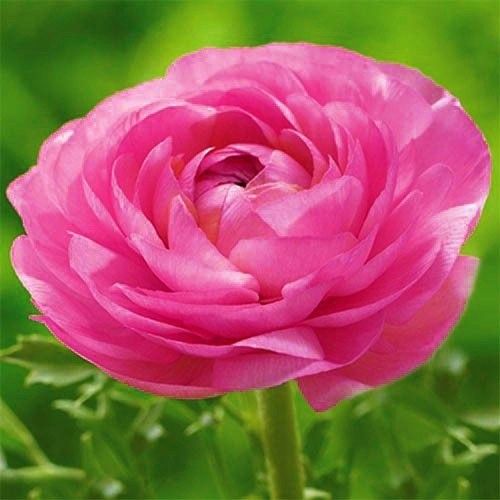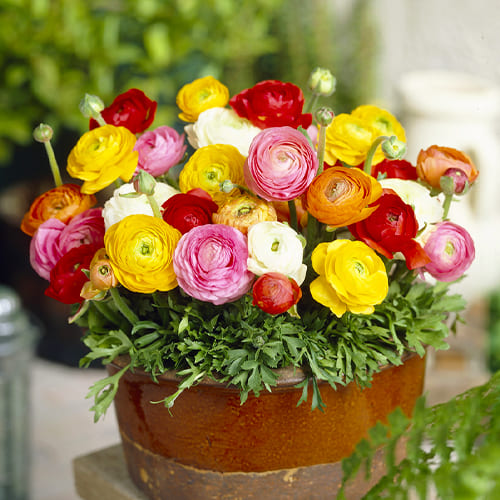
Ranunculus Asiaticus (Persian Buttercup)
Ranunculus Asiaticus (Persian Buttercup) Bulbs
Last Reviews
Many thanks!!
Ranunculus bulbs
Ranunculus is a beautiful flower with magnificent scales as petals. The flowers appear in the months of June and July, and they are popular cut flowers that have wonderful shades of colour. Ranunculus is a member of the ranunculaceae family, which includes a total of 1,300 to 2,000 species worldwide. Most are found in the temperate zone in the Northern Hemisphere. Ranunculus is ideal for use in bouquets, but also does very well as a single flower in a vase.
Ranunculus species and their origins
Ranunculus comes in the colours white, yellow, orange, pink, red and purple. The petals open one by one, gradually revealing the heart of the flower. Ranunculus originates from Central Asia and arrived in Europe via various detours. Here the flower was given the official name Ranunculus. This means frog in Latin, which is quite logical since Ranunculus is often found in swampy areas.

Symbolism of Ranunculus
Ranunculus is a symbol of charm. In the old Victorian days, when someone gave a bunch of Ranunculus to another person, this indicated that he or she found the other person very attractive. Of course, you can still make people happy with a colourful bunch of Ranunculus today, even if the symbolism behind it has been somewhat lost.
Planting ranunculus: how to do it
Ranunculus can be planted by planting the corms directly into the ground or into a flower pot in the spring or autumn. Place the corms in tepid water the evening before planting. When planting, bear in mind that the depth of the planting hole must be twice the height of the tuber. To put it simply: If the tuber is 5 cm tall, the hole should be 10 cm. The distance between the individual ranunculus tubers should be about 15 centimetres. First, loosen the soil well and plant the tuber with the roots pointing downwards. You can then fill the hole with soil again. If you do not want to plant the ranunculus one by one with a small spade, you can also use a special bulb-planter. Ranunculus is usually planted in spring, but it can also be planted in September or October. However, you should cover them with a good layer of dead leaves and hope for a mild winter.
Cultivating Ranunculus
Ranunculus needs at least half a day of sunlight every day. Make sure that the garden soil is fertile, well drained and not too dry. Use compost and peat and work it deeply. It is also good if the soil is humus- and nutrient-rich. The plants grow badly in dry and poor soil. Place the plants in a border or flowerbed, preferably in groups. This will produce the best results and also make the cheerful colours stand out better. Do you have Ranunculus in a pot? If so, it is best to use rose soil or a mixture of garden soil and potting soil. If you provide a somewhat sheltered spot, the hollow stems will not easily crack in the wind. Regularly remove spent flowers. As the plants are not winter hardy, pick up the tubers in October when the leaves have dried out. Then allow them to dry further and store them frost-free so that you can plant them again in the spring.
Ranunculus is also known as buttercup
Ranunculus is also known as buttercup. There are two species of buttercup that are common in our country. The sharp buttercup, Ranunculus acris, grows in verges, on dike slopes in meadows and hayfields. This species has a stem that is cylindrical, and you can feel it when you twist the flower between your thumb and forefinger. Do you want to know why this buttercup is called the sharp buttercup? Taste a very small piece of the plant, and you will immediately taste the sharpness of the taste on your tongue tip. Do spit it out immediately!

Ranunculus is easy to grow
Ranunculus is a beautiful and easy-to-grow garden plant with lacy leaves. They love the morning sun and are a real asset to any garden. But they are also beautiful as cut flowers in a vase at home or in the office. If you plant Ranunculus bulbs in pots in February, you can transplant them to the garden in mid-April. The best place for the pots is a warm spot facing south or west.
Tips on buying Ranunculus
It is best to buy large and firm root tubers with four or more strong 'claws' from February onwards. Never buy soft tubers, as they rot very quickly. Also avoid tubers with malformed or broken claws. If you live in a region where winters are severe, grow the Ranunculus in bowls on the window sill and do not place them in the garden until after the last frost. A feared disease of Ranunculus is root rot. This causes the tubers to rot and the whole plant to die. Too much water is often the main cause. Therefore, the best thing you can do is to water generously once (immediately after planting) and then only water again when the first shoots appear.
Tips for caring for Ranunculus in a vase
With the right care, Ranunculus can be kept for a very long time. Here are a few tips to make sure they last as long as possible. When placing them in a vase, cut off a section of the stem. Do this when the buds are already showing colour, as this is when they open best. Also use a clean vase with clean water and flower food. Too much water is not good for the hairy stems. Refill the vase regularly as Ranunculus is a very greedy drinker. Ranunculus thrives the best if placed in a cool spot, away from the sun and draughts. Do you know enough about Ranunculus and would you like to order Ranunculus bulbs through us? If so, please visit our online store and purchase them and other summer flowering bulbs with great ease.
Frequently asked questions about Spring Flowering Ranunculus Asiaticus (Persian Buttercup)
How to plant Ranunculus bulbs?
When to plant and grow ranunculus bulbs and corms?
Where to buy Ranunculus and Buttercup bulbs?
What colours are the flowers available in?
Ranunculus Asiaticus bulbs offer a wide range of colours, including bright red, soft pink, brilliant yellow, vibrant orange and more. Choose the colour that best suits your preferences from our range.
Are these bulbs hardy?
Ranunculus Asiaticus bulbs are usually not hardy and should be protected from frost. If you plant them outdoors, it is advisable to wait them out before the first frost and store them in a frost-free area until planting time comes around again next year.












